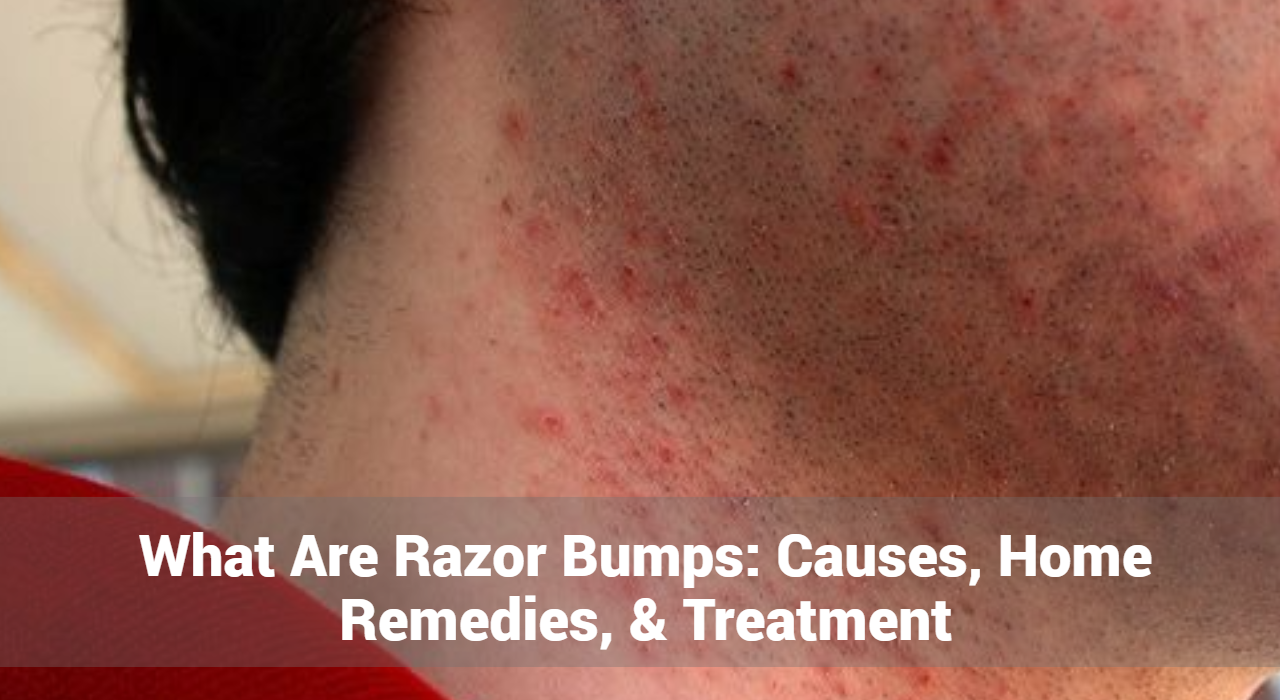What Are Razor Bumps: Causes, Home Remedies, & Treatment

Razor bumps, also known as pseudofolliculitis barbae, are a common skin condition that occurs after shaving. These tiny, irritated bumps develop when hair curls back into the skin, leading to inflammation and infection. Razor bumps can be painful and unsightly, affecting areas where hair is frequently shaved or waxed, such as the face, neck, legs, and bikini line. Understanding the causes, home remedies, and treatments for razor bumps is essential for effective management and prevention.
What Are Razor Bumps?
Razor bumps, medically known as pseudofolliculitis barbae, are small, irritated bumps that appear on the skin after shaving. These bumps can be painful, itchy, and unsightly, affecting areas where hair is frequently shaved, such as the face, neck, legs, underarms, and bikini line. Razor bumps are a common issue for both men and women and can lead to more serious skin conditions if not managed properly.
What Are The Symptoms of Razor Bumps?
Razor bumps, or pseudofolliculitis barbae, present with several distinct symptoms that can cause discomfort and aesthetic concerns. Understanding these symptoms is crucial for proper identification and management. Here are the common symptoms of razor bumps:
- Red or Dark Raised Bumps: The most noticeable symptom is the appearance of small, red or dark bumps on the skin where shaving has occurred. These bumps are often inflamed and can vary in size.
- Itching or Tenderness: The affected area may feel itchy or tender. The irritation can range from mild to severe, causing significant discomfort.
- Pus-Filled Bumps: In some cases, razor bumps can become infected, leading to the formation of pus-filled bumps that resemble pimples. These bumps may have a white or yellow center.
- Ingrown Hairs Visible Under the Skin: Razor bumps are often caused by ingrown hairs. These hairs can sometimes be seen looping back into the skin, appearing as tiny black dots or lines beneath the skin’s surface.
- Pain or Discomfort: Razor bumps can be painful, especially if they become inflamed or infected. The discomfort is often more pronounced when the area is touched or rubbed.
- Skin Discoloration: Persistent or severe razor bumps can lead to hyperpigmentation, causing dark spots or patches on the skin. This is more common in individuals with darker skin tones.
- Swelling: The area around the razor bumps may swell due to inflammation, adding to the discomfort and making the bumps more noticeable.
- Scarring: In severe cases, repeated or untreated razor bumps can lead to scarring, resulting in permanent changes to the skin’s texture and appearance.
- Hair Texture and Curliness: People with curly or coarse hair are more prone to developing razor bumps. The hair tends to curl back into the skin after shaving, causing irritation and inflammation.
- Improper Shaving Techniques: Shaving too closely, using a dull razor, or shaving against the grain can increase the risk of razor bumps. These practices cause the hair to be cut below the skin level, making it more likely to grow inward.
- Dry Shaving: Shaving without adequate lubrication or moisture can irritate the skin and lead to razor bumps. Dry shaving creates more friction, which can damage the skin and hair follicles.
- Clogged Hair Follicles: Dead skin cells, oil, and bacteria can clog hair follicles, trapping hair underneath the skin and causing razor bumps.
- Tight Clothing: Wearing tight clothing, especially immediately after shaving, can rub against the skin and exacerbate irritation, leading to the development of razor bumps.
Home Remedies for Razor Bumps
- Aloe Vera: Aloe vera gel has soothing and anti-inflammatory properties that can help reduce redness and irritation caused by razor bumps. Apply fresh aloe vera gel to the affected area and leave it on for about 20 minutes before rinsing with cool water.
- Warm Compress: Applying a warm compress to the affected area can soften the skin and hair, helping to release trapped hairs. Soak a clean cloth in warm water and place it on the razor bumps for a few minutes.
- Tea Tree Oil: Tea tree oil has antibacterial and anti-inflammatory properties that can help treat and prevent razor bumps. Dilute a few drops of tea tree oil with a carrier oil, such as coconut oil, and apply it to the affected area.
- Apple Cider Vinegar: Apple cider vinegar can help reduce inflammation and kill bacteria that may cause infection. Dilute apple cider vinegar with water in a 1:1 ratio and apply it to the razor bumps with a cotton ball.
- Exfoliation: Gently exfoliating the skin can remove dead skin cells and prevent hair from becoming trapped. Use a mild exfoliating scrub or a soft brush to exfoliate the affected area a few times a week.
- Witch Hazel: Witch hazel is a natural astringent that can reduce inflammation and soothe irritated skin. Apply witch hazel to the razor bumps using a cotton pad.
- Coconut Oil: Coconut oil has moisturizing and anti-inflammatory properties that can help soothe razor bumps. Apply a thin layer of coconut oil to the affected area and leave it on overnight.
Analyze Skin Diseases
Use our AI chatbot to determine your skin condition
What Are The Treatment Options for Razor Bumps?
- Topical Creams and Gels: Over-the-counter creams and gels containing hydrocortisone, salicylic acid, or glycolic acid can help reduce inflammation and exfoliate the skin. Prescription-strength retinoid creams can also be effective in treating razor bumps by promoting cell turnover and preventing hair from becoming trapped.
- Antibiotic Ointments: If razor bumps become infected, your doctor may prescribe an antibiotic ointment to apply to the affected area. This can help reduce infection and promote healing.
- Laser Hair Removal: Laser hair removal is a long-term solution for preventing razor bumps. The laser targets hair follicles, reducing hair growth and preventing hairs from becoming trapped under the skin.
- Electrolysis: Electrolysis is another long-term hair removal method that involves using an electric current to destroy hair follicles. This prevents hair from growing back and reduces the risk of razor bumps.
- Chemical Depilatories: Chemical depilatories are products that dissolve hair at the skin’s surface. They can be a good alternative to shaving, as they reduce the risk of hair becoming trapped under the skin. However, they may cause irritation in some individuals, so it’s important to test a small area first.
- Avoiding Shaving: If possible, giving the skin a break from shaving can help prevent the development of razor bumps. Consider alternative hair removal methods, such as waxing, sugaring, or using an electric razor, which may be gentler on the skin.
Prevention Tips for Razor Bumps
- Prepare Your Skin: Before shaving, soften your hair and skin by taking a warm shower or applying a warm towel to the area. Use a moisturizing shaving cream or gel to create a smooth surface for the razor.
- Use a Sharp Razor: Always use a sharp, clean razor to reduce friction and irritation. Replace your razor blades regularly to ensure a close and comfortable shave.
- Shave in the Right Direction: Shave in the direction of hair growth to minimize irritation and reduce the risk of hair becoming trapped under the skin.
- Rinse with Cool Water: After shaving, rinse the area with cool water to close the pores and reduce inflammation. Pat the skin dry with a clean towel.
- Moisturize: Apply a gentle, alcohol-free moisturizer after shaving to keep the skin hydrated and prevent dryness, which can contribute to razor bumps.
- Avoid Tight Clothing: Wear loose-fitting clothing, especially immediately after shaving, to reduce friction and irritation.
- Exfoliate Regularly: Incorporate regular exfoliation into your skincare routine to remove dead skin cells and prevent hair from becoming trapped under the skin.
When You Are Seeking advice from a dermatologist?
To alleviate these symptoms and prevent future occurrences, consider adopting a comprehensive skincare routine that includes proper shaving techniques, regular exfoliation, and the use of soothing, anti-inflammatory products. If symptoms persist or worsen, seeking consult a dermatologist is recommended.
Conclusion
Razor bumps can be a frustrating and uncomfortable condition, but with the right knowledge and care, they can be effectively managed and prevented. By understanding the causes of razor bumps and implementing appropriate home remedies and treatments, you can achieve smoother, healthier skin. The key is to adopt proper shaving techniques, maintain a good skincare routine, and seek professional experts advice when necessary. Embrace these practices to reduce the occurrence of razor bumps and enjoy a more comfortable shaving experience.





